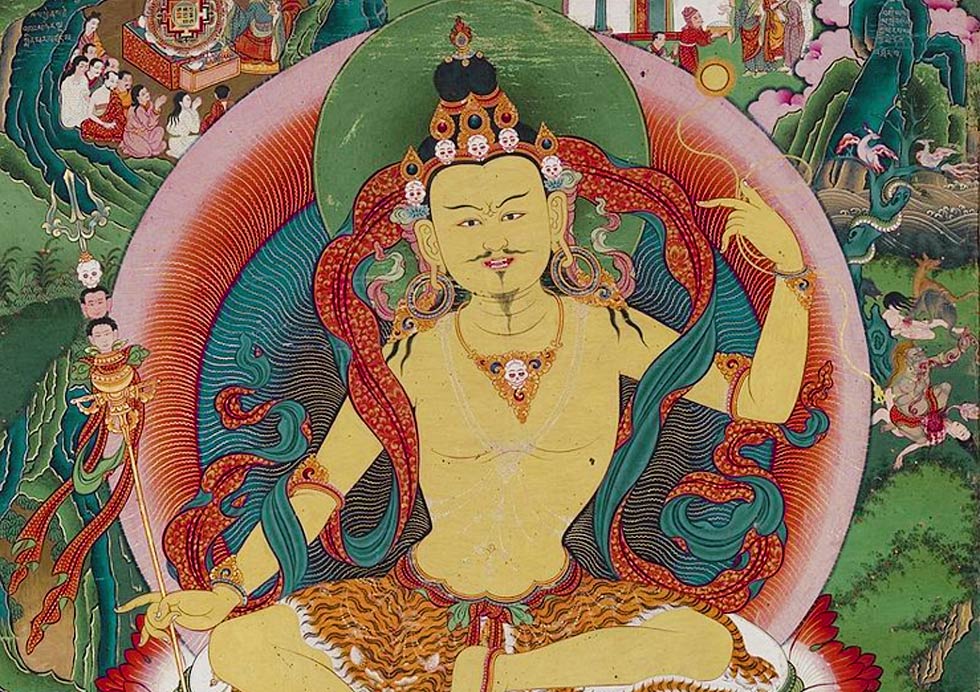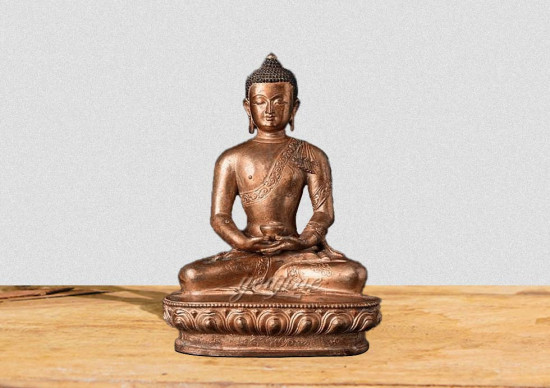
Thangka paintings are more than just beautiful traditional paintings. They show the heart of Tibetan Buddhism. These hand-painted works, often made on cotton or silk, feature many subjects, from the peaceful Buddha to mythical gods and detailed mandalas. Thangkas are both religious symbols and beautiful art, giving us a glimpse into the rich and complicated world of Tibetan spirituality.
What makes Buddhist Thangka paintings special isn’t just their meaning; they are also stunning art pieces. The tiny details, bright colors, and shiny gold leaf show the skill of the artists. Each brushstroke is carefully done to bring the images to life.
Thangka paintings aren’t just still images; they express faith and devotion. They serve as a visual aid for meditation, helping practitioners to visualize and connect with the divine.
What makes Buddhist Thangka paintings special isn’t just their meaning; they are also stunning art pieces. The tiny details, bright colors, and shiny gold leaf show the skill of the artists. Each brushstroke is carefully done to bring the images to life.
Thangka paintings aren’t just still images; they express faith and devotion. They serve as a visual aid for meditation, helping practitioners to visualize and connect with the divine.
The Origins and Purpose of Thangka Paintings
The exact origins of Buddhist Thangka paintings can be traced back to the ancient Indian art of manuscript painting. Over time, this tradition evolved and adapted to the unique cultural context of Tibet. Thangka paintings were initially created to serve as visual aids for Buddhist monks during religious ceremonies and meditation practices. The intricate details and symbolism within these paintings were designed to help practitioners visualize and connect with the divine.
Today, Thangka paintings continue to hold significant religious and cultural importance in Tibetan Buddhism. They are used in monasteries, temples, and homes as objects of devotion and meditation. Thangka paintings are also highly prized as works of art, with many collectors and enthusiasts drawn to their beauty and symbolism.
Today, Thangka paintings continue to hold significant religious and cultural importance in Tibetan Buddhism. They are used in monasteries, temples, and homes as objects of devotion and meditation. Thangka paintings are also highly prized as works of art, with many collectors and enthusiasts drawn to their beauty and symbolism.

The Techniques and Materials Used in Thangka Painting
Creating a Buddhist Thangka painting is a careful and long-lasting process that needs a lot of skill and talent. Artists start by getting ready the canvas, which is often made of cotton or silk. The canvas is then stretched onto a wooden frame and covered with a special substance to make it smooth.
After the canvas is ready, the artist starts to put on the colors. Thangka paints are made from natural things, like minerals, plant dyes, and gold leaf. The colors are mixed with a sticky substance and put onto the canvas with small brushes. The artist might also use a technique called "sgra-rtsis" (embossing) to make raised patterns and textures on the painting.
Thangka paintings are often decorated with gold leaf, which is put on in fancy patterns to make it look rich and holy. But nowadays gold leaf is not used. The gold leaf is usually put on using a burnishing technique, which means rubbing the gold onto the canvas with a polished agate stone.
After the canvas is ready, the artist starts to put on the colors. Thangka paints are made from natural things, like minerals, plant dyes, and gold leaf. The colors are mixed with a sticky substance and put onto the canvas with small brushes. The artist might also use a technique called "sgra-rtsis" (embossing) to make raised patterns and textures on the painting.
Thangka paintings are often decorated with gold leaf, which is put on in fancy patterns to make it look rich and holy. But nowadays gold leaf is not used. The gold leaf is usually put on using a burnishing technique, which means rubbing the gold onto the canvas with a polished agate stone.
The Symbolism and Iconography of Thangka Paintings
Buddhist Thangka paintings are full of symbols and pictures, with every part carefully chosen to mean something special. The main figure of the painting, often a god or saint, is surrounded by a lot of symbols and things. These symbols can mean the god's powers, qualities, or story of where they came from.
The colors used in Thangka paintings also have special meanings. For example, gold means enlightenment and living forever, red means kindness and power, and blue means wisdom and peace. How the painting is put together, including where the figures and things are placed, is also carefully thought about to tell a certain message or story.
The colors used in Thangka paintings also have special meanings. For example, gold means enlightenment and living forever, red means kindness and power, and blue means wisdom and peace. How the painting is put together, including where the figures and things are placed, is also carefully thought about to tell a certain message or story.
The Different Types of Thangka Paintings
There are several different types of Thangka paintings, each with its own unique characteristics and subject matter. Some of the most common types include:
- Deity Thangka: These paintings depict individual deities, such as Buddha, Avalokiteshvara, Padmasambhava, Manjushri or Tara.
- Mandala Thangka: Mandalas are symbolic diagrams that represent the universe and the interconnectedness of all things. Mandala Thangka paintings often depict intricate mandalas, filled with geometric patterns and deities.
- Narrative Thangka: These paintings illustrate stories from Buddhist mythology or history.
- NPortrait Thangka:N Portrait Buddhist Thangka paintings depict historical figures or individuals who have achieved spiritual enlightenment.
The Cultural Significance of Thangka Paintings

Thangka paintings are more than just beautiful pictures; they are strong ways to show Tibetan culture and spirituality. They give us a look into the rich and complicated world of Tibetan Buddhism, showing us the beliefs, practices, and values of this old tradition.
Thangka paintings also help to keep Tibetan culture and heritage alive. As Tibet has faced big problems with politics and culture in recent years, Thangka painting has become a symbol of strength and staying the same. By continuing to make and enjoy Thangka paintings, Tibetans are showing that their culture is important to them and keeping their special traditions for future generations.
Thangka paintings also help to keep Tibetan culture and heritage alive. As Tibet has faced big problems with politics and culture in recent years, Thangka painting has become a symbol of strength and staying the same. By continuing to make and enjoy Thangka paintings, Tibetans are showing that their culture is important to them and keeping their special traditions for future generations.
Conclusion
Thangka paintings are a testament to the enduring beauty and power of Tibetan art and culture. These intricate and vibrant scrolls offer a glimpse into the rich and complex world of Tibetan Buddhism, providing a window into the beliefs, practices, and values of this ancient tradition. Whether viewed as religious icons or simply as works of art, Thangka paintings.









